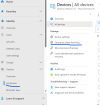britechguy
Well-Known Member
- Reaction score
- 4,853
- Location
- Staunton, VA
On my own machine, and every one I've ever touched in recent years, the first item in the General Pane (ALT + F, T) is the Cloud Storage Options section with a single checkbox: Store my Outlook settings in the cloud (requires restarting Outlook), which is checked by default.
The section that follows is the section entitled, User Interface Options, with a pair of radio buttons:
1. Optimize for best appearance [activated by default]
2. Optimize for compatibility (requires application restart)
I now have a client telling me that they do not have the Store my Outlook settings in the cloud (requires restarting Outlook) checkbox or its section at all, but on those systems the Optimize for compatibility radio button is activated.
I'm wondering if that compatibility option being activated might cause the Cloud Storage Options to be hidden.
The section that follows is the section entitled, User Interface Options, with a pair of radio buttons:
1. Optimize for best appearance [activated by default]
2. Optimize for compatibility (requires application restart)
I now have a client telling me that they do not have the Store my Outlook settings in the cloud (requires restarting Outlook) checkbox or its section at all, but on those systems the Optimize for compatibility radio button is activated.
I'm wondering if that compatibility option being activated might cause the Cloud Storage Options to be hidden.

